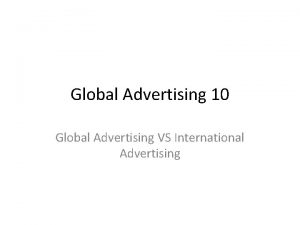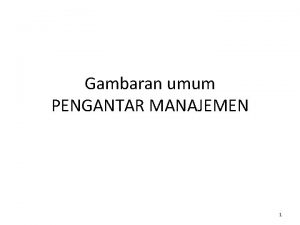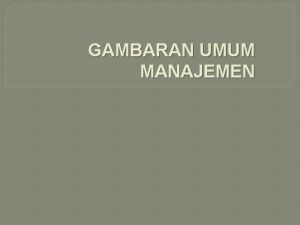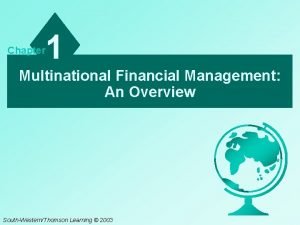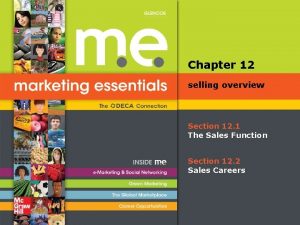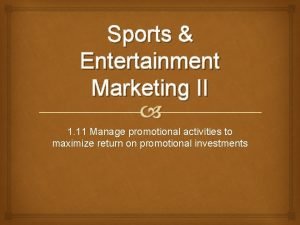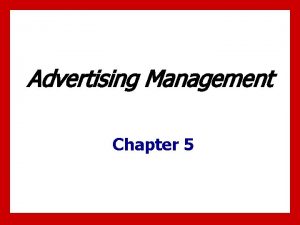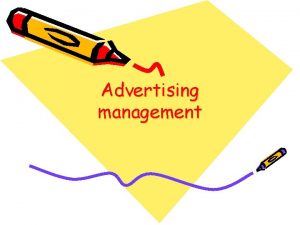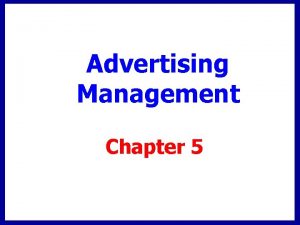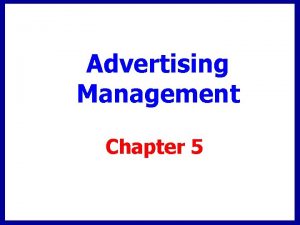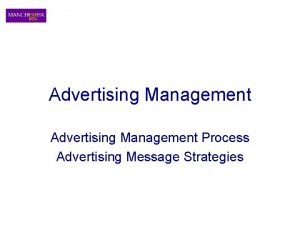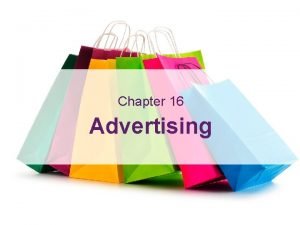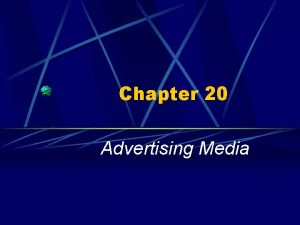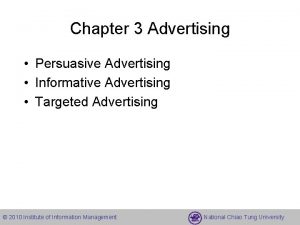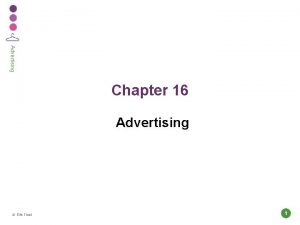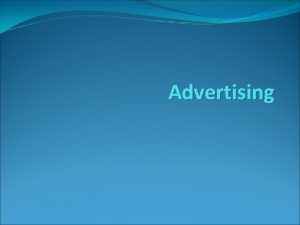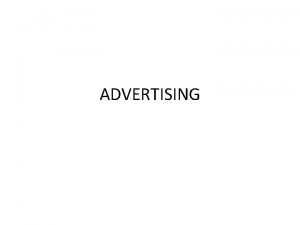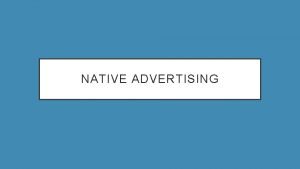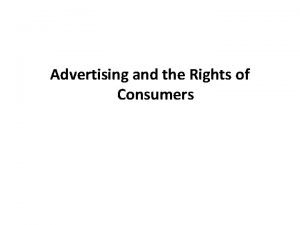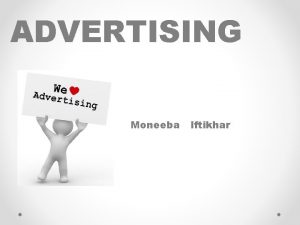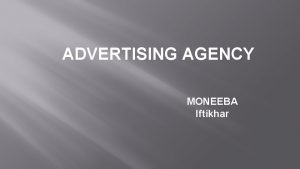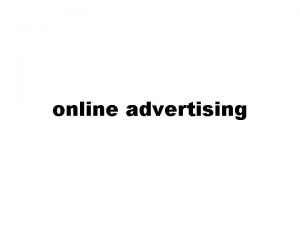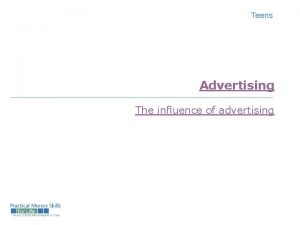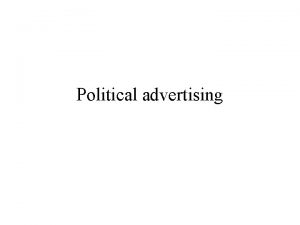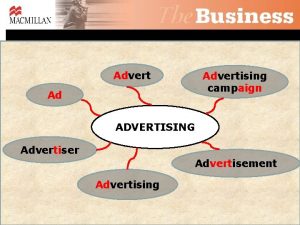Advertising Management Chapter 5 Chapter Overview Advertising management



























- Slides: 27

Advertising Management Chapter 5

Chapter Overview • Advertising management • Choosing an advertising agency • Advertising campaign management § § Research Budget Media selection Creative brief

Advertising Design Elements Advertising Strategy Chapter 5 Media Selection Chapter 8 Advertising Design Message Strategy & Framework Chapter 7 Appeals Chapter 6

Advertising Terms • Message theme § Key ideas § Connects to value § Attract attention § Delivery • Leverage point • Appeal • Executional framework

Advertising Management • Evaluate role of advertising in IMC program. • Selectin-house or external agency. • Developadvertising management strategy. • Developcreative brief.

Money Spent on Media Buy Creative Work Ad Production 10% 15% 75%

Advertising fit in IMC • Advertising still major component • Role of advertising varies • Business-to-business sector § Supporting role • Consumer sector § Primary communication vehicle

Oscar Mayer IMC Campaign

In-House or Advertising Agency Decision Criteria • • • The size of the account The media budget Objectivity Product complexity Creative ability

In-House versus Outside Agency In-House • Lower costs • Consistent message • Better understanding of product and mission • Faster • Lower turnover rate in the creative team • • Reduce fixed costs Greater expertise Outsider’s perspective Access to top talent F I G. 5. 4 Source: Adapted from Rupal Parekh, “Thinking of Pulling a Career. Builder? Pros and Cons of Bringing an Account In-House, ” Advertising Age, http: //adage. com/print? article_id 136701, May 18, 2009

Choosing an Agency • Screeninitial list of agencies § Reference requests § Retentionrate § Reasonfor switching agencies • Creative pitch § § Shootout 2 to 3 finalists Specific problem/situation Expensive for agencies • Agencyselection

Conflicts of Interest Leo Burnett Co. agencies do not serve competing firms. Company General Motors Hallmark Kellogg’s VISA Mc. Donald’s Allstate Gain Year Obtained Industry Account Automobile 1971 Greeting cards 1988 Cereal 1949 Credit cards 1979 Fast food 1981 Insurance 1957 Detergent 2000 Source: www. leoburnett. com.

Global Reach Grey Worldwide Advertising Company Sara Lee Kraft Foods Volkswagen 3 M Corporation Coca-Cola Cannon Playtex Toshiba # of Year Obtained Countries Account 21 1993 North America 2002 15 1998 14 1984 6 2004 5 1976 North America 1968 16 2007 Source: www. grey. com.

Advertising Campaign Management 1. 2. 3. 4. 5. Conduct/review advertising research Establish advertising objectives Review advertising budget Select media Prepare creative brief

Advertising Research 1 • Understand customers • Purchase benefits -not attributes • Product-specific research § Key selling points § Desirable features

Advertising Research 2 • Consumer-oriented research § Context of product use § Sociological analysis § Psychological motives • Focus groups

Typical Advertising Goals • To build brand image § Top of mind/standard choice • To inform, persuade • To support other marketing efforts § Encourageaction

Advertising Goals: Build Brand Image • Begins with brand awareness • Business-to-business § Especially important in modified rebuy situations • Brand equity leads to top-of-mind & top choice

Advertising Goals: Support Marketing Efforts • Consumer promotions • Retailers • Special sales • Promotional campaign

Advertising Goals: Encourage Action • Behavioral goals • Encourage some type of action § § Inquiry Access Web site Visit retail outlet Send e-mail or telephone

Advertising. Budget Distribution of spending over time • Continuousschedule § Maintain awareness • Flightingschedule § Spending at select times • Pulsatingschedule § Bursts of intensity

Media Selection • Media-usage habits of target market • Audience characteristics of media • Business-to-business media

Creative Brief What is. . . • The objective • The target audience • The message theme • The support • The constraints

The Constraints • Legal and mandatory restrictions • Constraints • Disclaimers

Creative Brief - Del Monte • The Objective– increase awareness of the smaller-size cans with pull-top lid. • Target Audience– senior citizens, especially those that live alone and suffer from arthritis. • Message Theme– the new cans not only contain a smaller portion but are easier to open. • Support– 30¢ intro coupon to encourage usage. • Constraints– copyright logo, toll free #, Web site, legal requirements of a coupon, and what is meant by a sma serving.

Del Monte Advertisement Based on the Creative Brief in the previous slide.

International Implications • 62% of advertising budgets spent outside of U. S. • Two major differences § Process of agency selection § Preparation of international advertising campaigns • Preplanning research varies • Understanding of languages and cultures • Media selection varies
 Chapter 1 an overview of financial management
Chapter 1 an overview of financial management Global advertising and international advertising
Global advertising and international advertising Introduction to content management
Introduction to content management Human resource management overview
Human resource management overview Project management topics
Project management topics Existing system of gym management system
Existing system of gym management system Real time interaction management
Real time interaction management Management overview
Management overview 4 prinsip taylor dalam tahapan
4 prinsip taylor dalam tahapan Overview of financial management
Overview of financial management Multinational financial management meaning
Multinational financial management meaning Overview of financial management
Overview of financial management A 23 year old male experienced severe head trauma
A 23 year old male experienced severe head trauma Chapter 14 medical overview
Chapter 14 medical overview Chapter 9 lesson 2 photosynthesis an overview
Chapter 9 lesson 2 photosynthesis an overview Chapter 12 selling overview
Chapter 12 selling overview Financial intermediaries
Financial intermediaries Chapter 1 overview of verb tenses
Chapter 1 overview of verb tenses Overview of personal finance chapter 1
Overview of personal finance chapter 1 Mesioclusion
Mesioclusion Introduction to personal finance chapter 1 answers
Introduction to personal finance chapter 1 answers Chapter 32 an overview of animal diversity
Chapter 32 an overview of animal diversity Elements and their properties section 1 metals
Elements and their properties section 1 metals Chapter 1 overview of financial statement analysis
Chapter 1 overview of financial statement analysis Advertising management and sales promotion
Advertising management and sales promotion Objectives of advertising management
Objectives of advertising management Www stands for world wide web
Www stands for world wide web Maximo work order priority
Maximo work order priority

